
© Bermuda Civic Ballet. (Click image for larger version)
www.bermudacivicballet.bm
Bermuda Royal Gazette report on the performances:
“Civic Ballet’s 40th Anniversary production features six Croatian dancers”
Bermuda is a jewel of a small island standing alone in the Atlantic and boasting turquoise seas, pink sands, pastel coloured houses with white roofs, cackling yellow-breasted kiskadee birds and, of course, Bermuda shorts in all hues worn with long socks, blazers and ties. It’s a blissful atmosphere especially in August when the sun is high and the sea and pools are body temperature.
But it’s not all about swimming and relaxing and away from the beaches there is a selection of culture on offer. Contributing a huge part to that is the Bermuda Civic Ballet which this year sees its 40th anniversary. To celebrate the occasion, dancers from its school and summer school, together with local dramatic talent, joined principals from the Croatian National Ballet to present the premiere of Romeo and Juliet by Croatian choreographer Svebor Secak, staged in the open air on the ramparts of the old British fortress, Fort Hamilton.
Civic (as it is called colloquially) can boast direct links back to the Imperial Russian Ballet through one of its dancers, Nicolas Legat. His favourite pupil and protégé was the Yugoslavian ballerina, Ana Roje, and in turn, it was one of her own pupils who became the lynchpin in bringing Russian classical ballet to the beautiful lobster shaped isle. Patricia Deane Gray, an indefatigable and dedicated dancer, teacher, director and now historian, introduced classical ballet training into Bermuda in the 1950’s and has spent her life training and developing young Bermudian dancers, as well as promoting and preserving the Legat legacy throughout the ballet world.(Sadly this method of technique is now disappearing from most ballet schools’ syllabi.) Now retired from director duties, she is still very much involved.
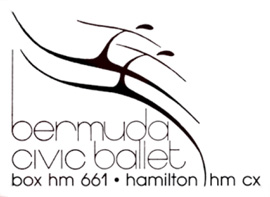
Before the advent of the Russian training, various little dance schools offered classes to Bermudian children, but they lacked formal training and certainly gave little explanation or reason for the steps being taught. However, it was in one of these schools that young Patricia Sherwood (Deane Gray) began what was to become, a very long career in the ballet world. She was a natural dancer, starting at three and by 14, was teaching and coaching aspiring fellow students. A year later she graduated from the Bermuda High School for Girls and set sail for England to enrol in the Legat School in Sussex where she found the discipline and formality of true classical ballet technique that she so badly needed. Her perseverance and all-absorbing passion for her studies quickly caught the eye of her teacher, Ana Roje, who took her under her wing. When Madame Roje returned to Yugoslavia to open the Roje-Harmos International Ballet School in Kastel Kambelovac near Split, Patricia went with her and was soon dancing soloist roles in the National Theatre in Split. Later she accompanied Madame Roje to New York for six months before returning to England to obtain her own teaching degree in the Foundation of Russian Ballet. A career beckoned in Croatia, but so did love in Bermuda, and the latter won. She returned to her homeland to marry and have two children, but not to turn her back on her first love – ballet
In 1955 she opened her School of Russian Classical Ballet, determined to offer the best training for young girls who wanted a professional career as well as those who just wanted to dance. The school went from strength to strength and over the years has produced some fine dancers, who have performed not just with Bermuda Civic Ballet but also with international companies such as Moscow’s Stanislavsky Ballet, The Dance Theatre of Harlem and more recently, Corella Ballet in Spain.

© Margaret Willis. (Click image for larger version)
Other schools popped up over the island, offering training in differing techniques including RAD, but there was little opportunity for any of the students to gain performance experience. In 1957, Madame Roje accepted an invitation to visit Bermuda and was impressed by the training that the students were receiving. She returned the next year to stage Giselle, bringing principals with her but using the school pupils as corps de ballet, and she returned regularly to teach the Legat method at both the school and summer school. Her husband, choreographer Oskar Harmos, staged the school’s first highly successful production, ’Devil in the Village’ which featured 140 local Bermudian performers, many of whom were not dancers but professional people from all walks of life who were eager to participate in the show. Bermudians had now a taste for ballet and performances by invited overseas guests became the norm though local dancers had no opportunity to dance. To remedy this, Bermuda Civic Ballet was formed in1972, enthusiastically supported by a band of community leaders and sponsors. This fledgling semi-professional company went on to present full-length classics, such as La Fille mal Gardee, Les Sylphides, Don Quixote, La Peri, Giselle, Coppelia, as well as works created by Bermudian choreographers to Bermudian music. In 1978, the company was invited to participate in the Festival of Youth Orchestras and Performing Arts in Aberdeen and then in London where it was well received and invited to return three years later. BCB has become the longest-established cultural society on the island.
Teacher, examiner and consultant with the Legat Foundation in Croatia, Mrs Gray has been recognized many times for her dedication to the art of ballet in Bermuda and was awarded the MBE in 1984 by HM The Queen. She continues to organize the Ana Roje international Ballet School usually held in Croatia, though this summer it was held in Bermuda. She now presents a travelling exhibit on Legat, which has already been seen in 27 different places in Canada, America, Russia and Austria.
Today the school is run by one of the company’s first ballerinas, Coral Patterson Waddell, and there are approximately 150 pupils enrolled who attend Tuesday to Saturday. Her son, James Waddell, a tall, handsome young man with obvious talent, is a graduate of Central School in London and recently has been a member of Angel Corrella’s company in Spain. Most of today’s ballet pupils were involved in Civic’s 40th anniversary celebration production of Romeo and Juliet – the older girls on pointe, the younger ones acting as pages and townsfolk.

© Margaret Willis. (Click image for larger version)
Prokofiev and the Peeping Frogs’ Chorus
Romeo and Juliet
Bermuda, Fort Hamilton
15 – 22 September 2012
There couldn’t have been a better setting for this Bermudian Romeo and Juliet. It was dramatically and effectively staged, using the different heights of the ramparts of Fort Hamilton overlooking the harbour with a natural backdrop of stars and crescent moon. At least it was a perfect setting on three of the four nights, as opening night was literally washed out by a tropical storm. The show had to be cancelled before the first step had been made on the stage. Water flowed down the rocks and across the stages, and the audience’s seats were filled with puddles. But the following night was starry and clear, though the wet made the tiny nocturnal tree frogs peep louder than ever, sometimes threatening to drown out Prokofiev’s magnificent recorded score.
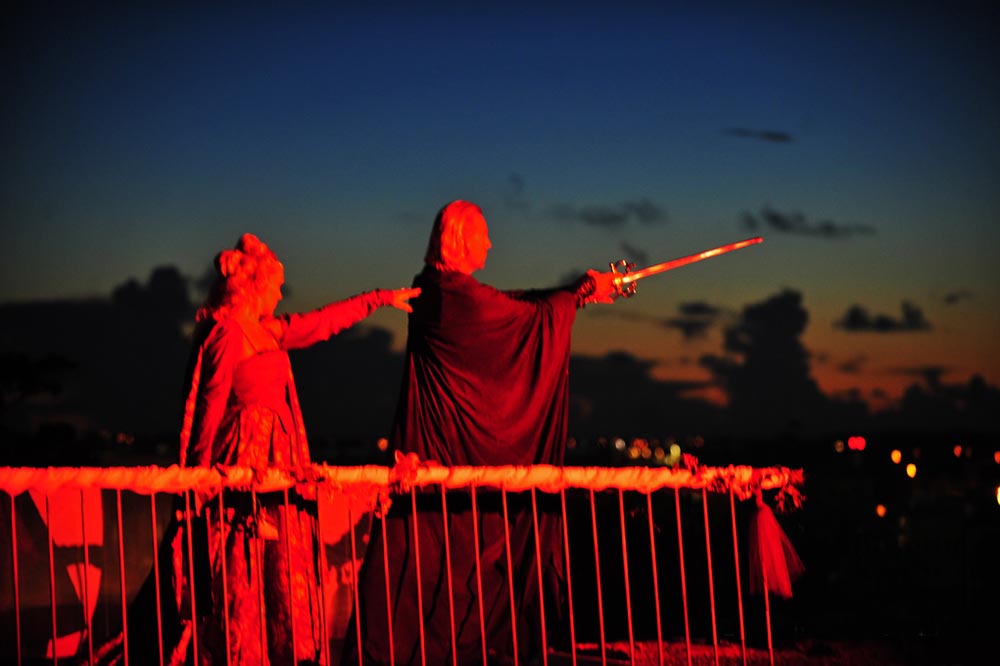
© Chinaman Productions. (Click image for larger version)
Svebor Secak, a tall, imposing ex-principal dancer of Croatian National Ballet, created this bold and entertaining production of Shakespeare’s famous love-story especially for Civic Ballet’s 40th anniversary. Bermudians already knew him, since three years ago he had successfully staged and performed the leading role in his ballet, Hamlet, with a small group of Croatian dancers. This time over 50 people were involved in his creation, from imported professional dancers to students, local dancers and actors, fencing club members and extras from the community – architects, accountants, teachers, bankers etc. The choreography was carefully created to fit all of the varying standards while keeping the pace and drama of the story, and with costumes from Croatian National Ballet brought over by Andreja Kovacic, the production looked lush and colourful. The classical choreography for the main roles saw fluidity, good pacing and dramatic bravura, which delighted the audiences. The fight scenes were fast and convincing, while the fire twirlers in the carnival caused a buzz as they looked very effective in the dark night. With just two acts – acts 2 and 3 were combined – Secak invited an actor to set the scenes with some of Shakespeare’s speeches.
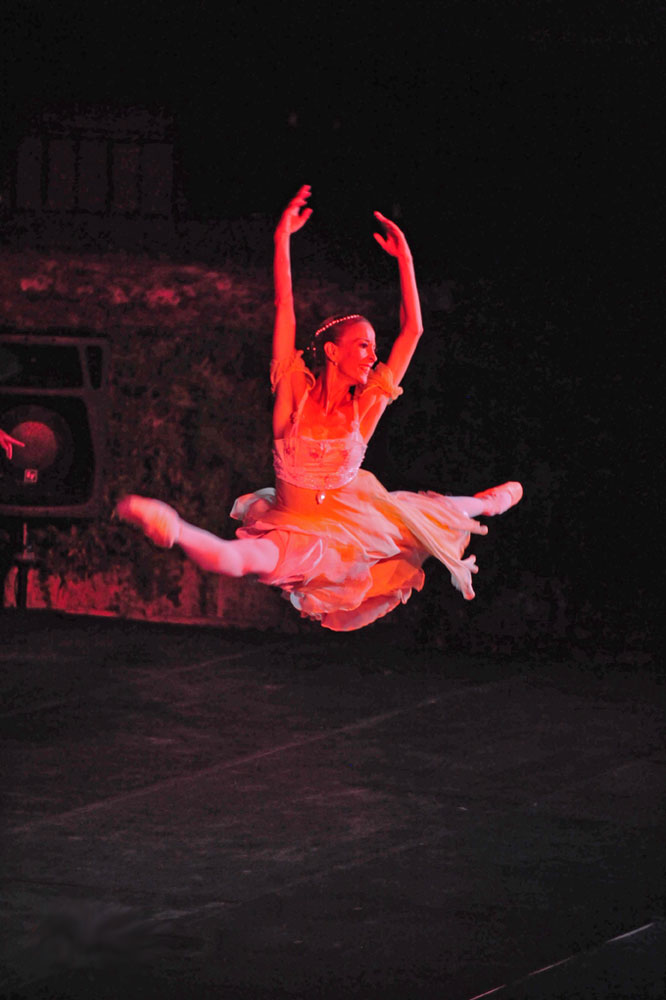
© Chinaman Productions. (Click image for larger version)
It was a truly international event. The six Croatian National Ballet members hailed from five different countries: Tomislav Petranovic (Romeo) and Edina Plicanic, (Juliet) are Croatian: Robert Bruist (Benvolio) is Australian; Guilherme Alves (Paris) Portuguese: Silviu Tanase (Tybalt) Romanian: and Kristian Manev (Mercutio) Bulgarian. Secak played the role of Lord Capulet while American David Drummond (Boston Ballet) took the role of Friar Lawrence. The UK was represented by Laura Hussey (ex London City Ballet and English National Ballet) as Lady Capulet, and yours truly, who was Juliet’s Nanny. Two students, Lydia Mackenzie and Sophie Bartlett, from St Bede’s Legat School in Sussex, had stayed on after summer school to dance as Juliet’s friends along with Italian student, Elena Meola, and her compatriot, Kevin Regonesi, who, together with James Waddell, were Tybalt’s friends.
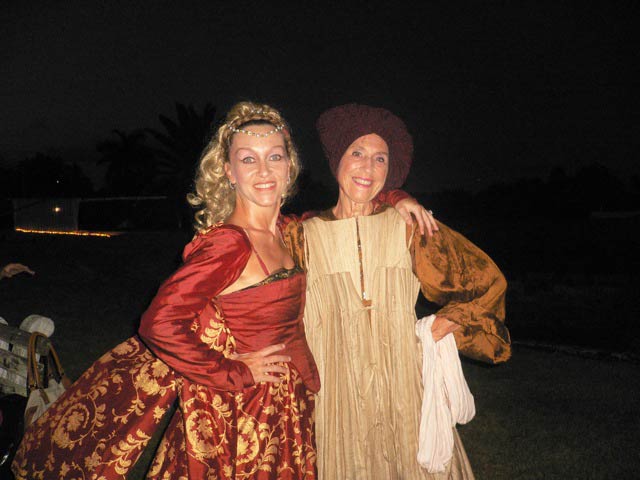
© Margaret Willis. (Click image for larger version)
Before the principals arrived, rehearsals took place each evening in the Sunday School of a local church for the amateur extras, as well as the six ballet students. First rehearsals when the principals arrived were somewhat of a mystery regarding spacing. On the vast Sunday School floor, a tiny area was marked out with blue tape which apparently was Juliet’s bedroom, where most of my actions took place. Moving in this small space, I had no idea why Laura kept hissing, ‘You’ve fallen over the edge” when I’d step over the unseen back blue line on my solo. All became clear when we finally went to the Fort to see the multi tiered set that had been constructed up on the ramparts between two huge green cannons. Our Capulet domain was on an eyrie high above the main stage with a floor space of approximately 4’ X 10’ and open to sheer drops on three sides. Technique went out the window as knees knocked and the light faded, and both Juliet and I thought only of not stepping backwards in the dark to an early doom. It wouldn’t have been so bad with just the two of us, but we were joined by Lady C, Paris and his page and the original choreography also had me dragging a large chair around. (Romeo immediately stated that he had no intention of climbing the metal ladder and running across the ‘ravine’ on a bare board to get to Juliet’s room, so the board was removed which made the hole look even deeper.) A few quiet mutterings about ‘insurance’ and ‘health and safety’ mercifully produced a metal balcony around the tiny stage two days later, and confidence returned. The dungeon into which we might have fallen became the Friar’s chapel but we still had to scramble up and down the rocks and grass in the dark to perform on the main stage – Juliet turned into an elegant mountain goat in her racing back and forth for her rendezvous with Romeo. Another occupational hazard was remembering to check costumes, before putting them on, for the little chirping frogs, which also claimed space on the railings where we hung our clothes.
Manev (Mercutio) performed with bounding vivacity and buoyancy and was most entertaining in his repartee with Tybalt. Bruist, (Benvolio) has an admirable light springy jump from which he comes down through his whole foot into a soft plie and he made a good impression with his speedy footwork and quick turns. The tall Tanase offered an arrogant Tybalt, oozing with self -importance and conceit, and danced with authority. Gameiro Alves as Paris was almost too good-looking with his dark hair and engaging smile for Juliet not to want, but he acted with cool detachment and assurance, showing off some high double turns.
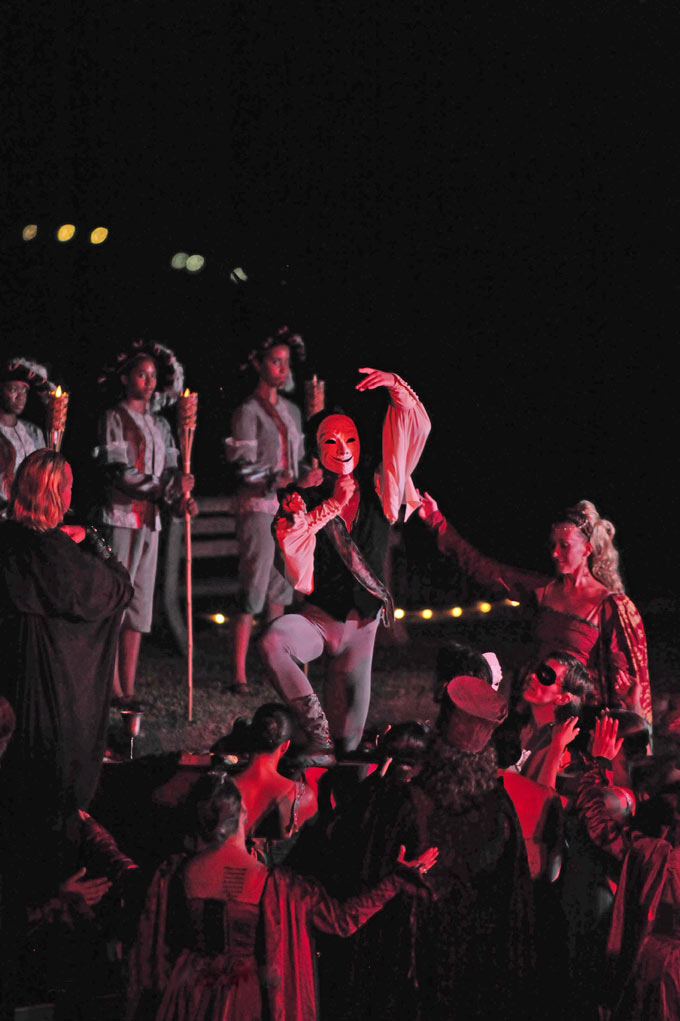
© Chinaman Productions. (Click image for larger version)
Petranovic was ardent and spirited as Romeo – a local, fun-loving lad and a contrast to the higher class Capulet family. One wondered whether Juliet had been spying on his antics in the town square from her balcony, and thus recognized him at the ball. He executed good multiple turns, powerful leaps and clean footwork and was a strong partner, especially given the challenges of spacing in some of the pas de deux.

© Margaret Willis. (Click image for larger version)
Edina Plicanic made a sweet and gentle Juliet, full of fun with her Nanny, excited about the ball and tender with Romeo, determined to obey her heart rather than the family’s desires. She has a lovely easy extension, is light footed and like quicksilver and fulfilling her thrice nightly up and downhill marathon from Capulet’s domain to centre stage, briskly yet carefully. Her ethereal personality was made even more so in lifts high up on the top stage where the evening breeze caught her chiffon skirt, and the half moon and shooting stars made the whole thing real. Laura Hussey made a strong and dramatic Lady Capulet (her glarings at me in Juliet’s bedroom sent shivers down my spine!) while Secak made a striking Lord Capulet in his flowing cape and with his powerful actions that depicted his power.
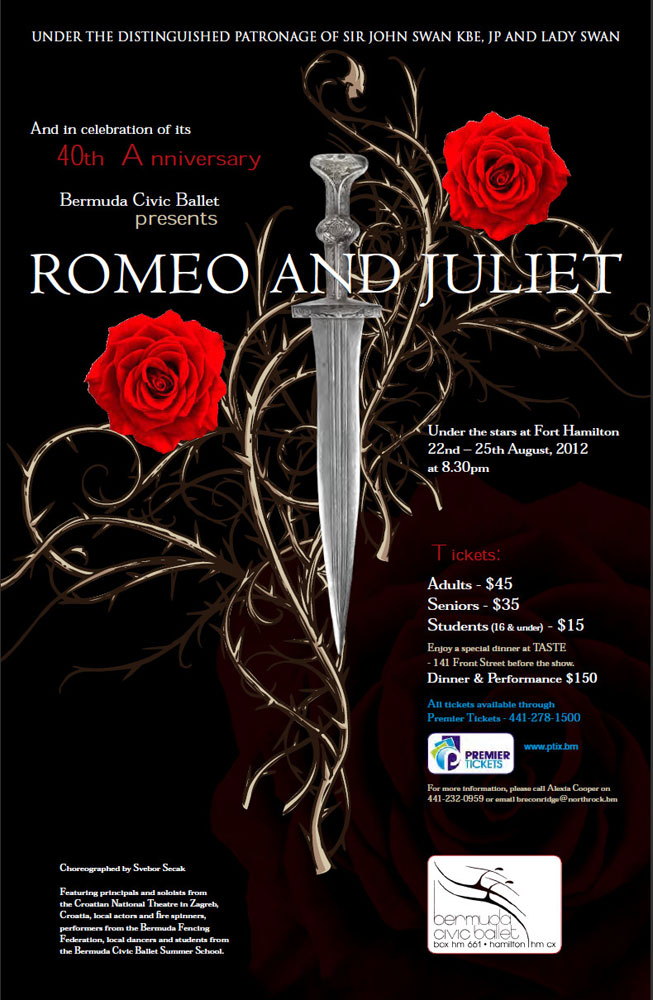
© Bermuda Civic Ballet. (Click image for larger version)
Having missed first night due to the weather, the Governor of Bermuda, George Fergusson, with his wife, attended the final performance and came on stage at the end and shook hands with everyone in the production – just like a Royal Command performance. “I would have loved to have done your role, his wife said to me.’ You must have had great fun.” I had to agree. It was truly a remarkable summer.













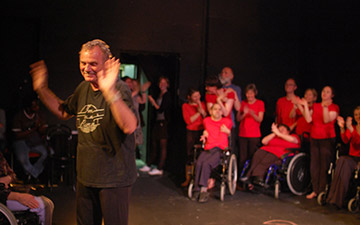



You must be logged in to post a comment.